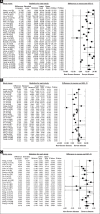Gastrointestinal predictors of severe COVID-19: systematic review and meta-analysis
- PMID: 33162738
- PMCID: PMC7599357
- DOI: 10.20524/aog.2020.0527
Gastrointestinal predictors of severe COVID-19: systematic review and meta-analysis
Abstract
Background: COVID-19 pandemic has created a need to identify potential predictors of severe disease. We performed a systematic review and meta-analysis of gastrointestinal predictors of severe COVID-19.
Methods: An extensive literature search was performed using PubMed, Embase, Web of Science and Cochrane. Odds ratio (OR) and mean difference (MD) were calculated for proportional and continuous outcomes using a random-effect model. For each outcome, a 95% confidence interval (CI) and P-value were generated.
Results: A total of 83 studies (26912 patients, mean age 43.5±16.4 years, 48.2% female) were included. Gastrointestinal predictors of severe COVID-19 included the presence of diarrhea (OR 1.50, 95%CI 1.10-2.03; P=0.01), elevated serum aspartate aminotransferase (AST) (OR 4.00, 95%CI 3.02-5.28; P<0.001), and elevated serum alanine aminotransferase (ALT) (OR 2.54, 95%CI 1.91-3.37; P<0.001). Significantly higher levels of mean AST (MD 14.78 U/L, 95%CI 11.70-17.86 U/L; P<0.001), ALT (MD 11.87 U/L, 95%CI 9.23-14.52 U/L; P<0.001), and total bilirubin (MD 2.08 mmol/L, 95%CI 1.36-2.80 mmol/L; P<0.001) were observed in the severe COVID-19 group compared to non-severe COVID-19 group.
Conclusion: Gastrointestinal symptoms and biomarkers should be assessed early to recognize severe COVID-19.
Keywords: COVID-19; SARS-CoV-2; diarrhea; predictors; severe COVID-19.
Copyright: © Hellenic Society of Gastroenterology.
Conflict of interest statement
Conflict of Interest: None
Figures




References
-
- Ket JCF, Otten RHJ, Van Dusseldorp I. [Accessed 3 July 2020];KNVI biomedische informatie search blocks/Zoekblokken. Available from: https://blocks.bmi-online.nl/catalog/397 .
LinkOut - more resources
Full Text Sources
Miscellaneous
